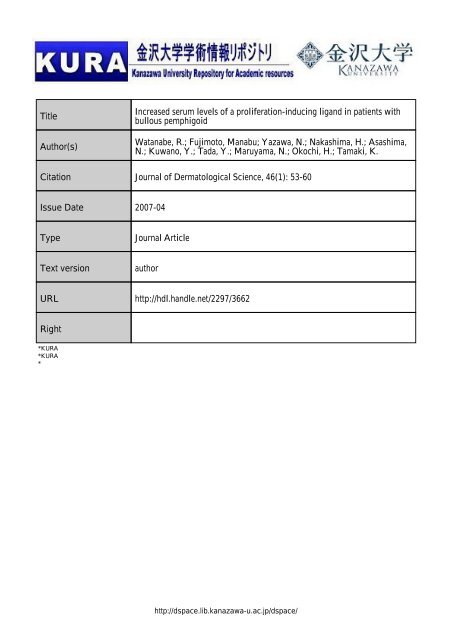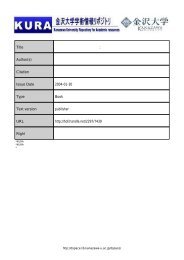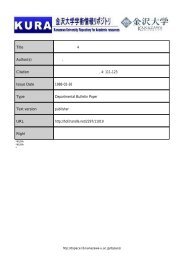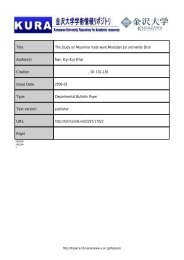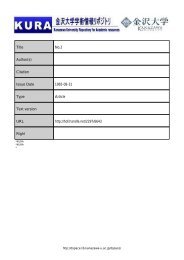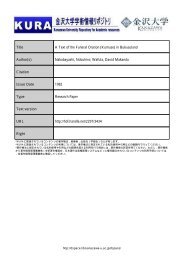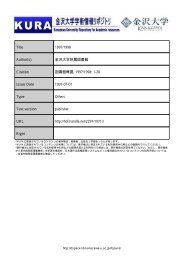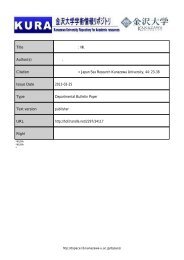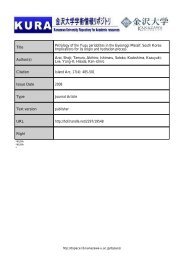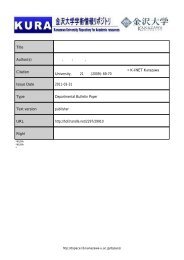Title Increased serum levels of a proliferation-inducing ligand in ...
Title Increased serum levels of a proliferation-inducing ligand in ...
Title Increased serum levels of a proliferation-inducing ligand in ...
You also want an ePaper? Increase the reach of your titles
YUMPU automatically turns print PDFs into web optimized ePapers that Google loves.
<strong>Title</strong><br />
Author(s)<br />
Citation<br />
<strong>Increased</strong> <strong>serum</strong> <strong>levels</strong> <strong>of</strong> a prolife<br />
bullous pemphigoid<br />
Watanabe, R.; Fujimoto, Manabu; Yaz<br />
N.; Kuwano, Y.; Tada, Y.; Maruyama,<br />
Journal <strong>of</strong> Dermatological Science,<br />
Issue Date 2007-04<br />
Type<br />
Journal Article<br />
Text version author<br />
URL<br />
http://hdl.handle.net/2297/3662<br />
Right<br />
*KURAに 登 録 されているコンテンツの 著 作 権 は, 執 筆 者 , 出 版 社 ( 学 協 会 )などが 有 します。<br />
*KURAに 登 録 されているコンテンツの 利 用 については, 著 作 権 法 に 規 定 されている 私 的 使 用 や 引 用 などの 範 囲 内 で 行 ってください。<br />
* 著 作 権 法 に 規 定 されている 私 的 使 用 や 引 用 などの 範 囲 を 超 える 利 用 を 行 う 場 合 には, 著 作 権 者 の 許 諾 を 得 てください。ただし, 著 作 権 者<br />
から 著 作 権 等 管 理 事 業 者 ( 学 術 著 作 権 協 会 , 日 本 著 作 出 版 権 管 理 システムなど)に 権 利 委 託 されているコンテンツの 利 用 手 続 については<br />
, 各 著 作 権 等 管 理 事 業 者 に 確 認 してください。<br />
http://dspace.lib.kanazawa-u.ac.jp/dspac
<strong>Increased</strong> <strong>serum</strong> <strong>levels</strong> <strong>of</strong> a <strong>proliferation</strong>-<strong><strong>in</strong>duc<strong>in</strong>g</strong> <strong>ligand</strong> <strong>in</strong> patients with bullous<br />
pemphigoid<br />
<strong>Increased</strong> <strong>serum</strong> APRIL <strong>levels</strong> <strong>in</strong> bullous pemphigoid<br />
R. WATANABE, M. FUJIMOTO † , N. YAZAWA, H. NAKASHIMA, N. ASASHIMA, Y.<br />
KUWANO, Y. TADA, N. MARUYAMA ‡ , H. OKOCHI § , and K. TAMAKI<br />
Department <strong>of</strong> Dermatology, Faculty <strong>of</strong> Medic<strong>in</strong>e, University <strong>of</strong> Tokyo, 7-3-1 Hongo,<br />
Bunkyo, Tokyo, 113-8655, Japan<br />
† Department <strong>of</strong> Dermatology, Kanazawa University Graduate School <strong>of</strong> Medical<br />
Science, 13-1 Takaramachi, Kanazawa, Ishikawa 920-8641, Japan.<br />
‡ Division <strong>of</strong> Biostatistics, School <strong>of</strong> Pharmaceutical Science, Kitasato University, 5-9-1<br />
Shirokane, M<strong>in</strong>ato, Tokyo, 108-8641, Japan<br />
§ Department <strong>of</strong> Tissue Regeneration, International Medical Center <strong>of</strong> Japan, 1-21-1<br />
Toyama, Sh<strong>in</strong>juku, Tokyo, 162-8655, Japan<br />
Correspondence to:<br />
M Fujimoto<br />
E-mail: fujimoto-m@um<strong>in</strong>.ac.jp Department <strong>of</strong> Dermatology, Kanazawa University<br />
Graduate School <strong>of</strong> Medical Science, 13-1 Takaramachi, Kanazawa, Ishikawa 920-8641,<br />
Japan.<br />
Phone: +81-76-265-2341<br />
Fax: +81-76-234-4270<br />
Keywords.<br />
- 1 -
APRIL, pemphigus vulgaris, bullous pemphigoid, autoimmunity, anti-BP180 antibody<br />
- 2 -
Abstract<br />
Background: B cells have been demonstrated to have critical roles <strong>in</strong> develop<strong>in</strong>g<br />
autoimmune bullous diseases. Recently identified tumor necrosis factor-like molecules,<br />
B cell-activat<strong>in</strong>g factor <strong>of</strong> the TNF family (BAFF) and a <strong>proliferation</strong>-<strong><strong>in</strong>duc<strong>in</strong>g</strong> <strong>ligand</strong><br />
(APRIL) are essential molecules for B cell development, survival, and <strong>proliferation</strong>.<br />
Although the functions <strong>of</strong> APRIL have not been fully evaluated, recent studies suggest<br />
that circulat<strong>in</strong>g <strong>levels</strong> <strong>of</strong> APRIL are <strong>in</strong>creased <strong>in</strong> various autoimmune diseases,<br />
<strong>in</strong>clud<strong>in</strong>g systemic lupus erythematosus and rheumatoid arthritis.<br />
Objectives: To determ<strong>in</strong>e <strong>serum</strong> APRIL <strong>levels</strong> <strong>in</strong> patients with pemphigus vulgaris<br />
(PV) and bullous pemphigoid (BP), and compare those with cl<strong>in</strong>ical f<strong>in</strong>d<strong>in</strong>gs and<br />
laboratory f<strong>in</strong>d<strong>in</strong>gs.<br />
Patients/Methods: Sera from 15 PV patients, 43 BP patients, and 15 normal controls<br />
were subjected to ELISA assays to measure <strong>serum</strong> APRIL, BAFF, Dsg3, and BP180<br />
- 3 -
<strong>levels</strong>.<br />
Results and Conclusions: Circulat<strong>in</strong>g APRIL <strong>levels</strong> were significantly elevated <strong>in</strong> BP<br />
patients but not <strong>in</strong> PV patients, and correlated with <strong>serum</strong> BAFF <strong>levels</strong>. Our study<br />
revealed that <strong>serum</strong> APRIL <strong>levels</strong> tended to be <strong>in</strong>creased <strong>in</strong> the quite early stage <strong>of</strong><br />
disease. In conclusion, circulat<strong>in</strong>g APRIL <strong>levels</strong> may be a useful marker for early<br />
activation <strong>of</strong> autoimmune diathesis, and furthermore, an effective therapeutic target<br />
molecule <strong>in</strong> patients with BP.<br />
- 4 -
Introduction<br />
Autoimmune bullous diseases are characterized by autoantibodies aga<strong>in</strong>st specific<br />
adhesion molecules <strong>of</strong> the sk<strong>in</strong> and/or mucous membrane. For <strong>in</strong>stance, patients with<br />
pemphigus vulgaris (PV) carry autoantibodies specific to a desmosomal prote<strong>in</strong><br />
desmogle<strong>in</strong> 3 (Dsg3), while bullous pemphigoid (BP) is dist<strong>in</strong>guished by autoantibodies<br />
directed aga<strong>in</strong>st a hemidesmosomal prote<strong>in</strong> called BP180. Although these<br />
autoantibodies are widely known to play a primary role <strong>in</strong> the disease<br />
manifestation[1-5], both <strong>in</strong> animal models and human, it rema<strong>in</strong>s unknown how these<br />
disease-specific autoreactive B cells and autoantibodies are <strong>in</strong>duced.<br />
Recent evaluation on the role <strong>of</strong> B cells <strong>in</strong> autoimmune diseases has <strong>in</strong>dicated that B<br />
cells have more critical functions <strong>in</strong> regulat<strong>in</strong>g immune responses than just the<br />
precursors <strong>of</strong> antibody-secret<strong>in</strong>g cells. Furthermore, B cell depletion therapy with<br />
anti-CD20 monoclonal antibody turned out to be effective <strong>in</strong> the management <strong>of</strong><br />
- 5 -
autoimmune diseases, <strong>in</strong>clud<strong>in</strong>g autoimmune blister<strong>in</strong>g diseases[6-19]. Several studies<br />
have also demonstrated that cytok<strong>in</strong>es, such as tumor necrosis factor (TNF)-α, play<br />
important roles <strong>in</strong> these blister<strong>in</strong>g diseases, supported by the validity <strong>of</strong> the treatment<br />
with monoclonal anti-TNF-α antibodies <strong>in</strong> severe PV[20, 21].<br />
Recently identified two TNF family molecules, B cell-activat<strong>in</strong>g factor <strong>of</strong> the TNF<br />
family (BAFF) and a <strong>proliferation</strong>-<strong><strong>in</strong>duc<strong>in</strong>g</strong> <strong>ligand</strong> (APRIL), have received <strong>in</strong>creas<strong>in</strong>g<br />
attention as key regulators <strong>of</strong> normal B cell functions and autoimmune B cell<br />
<strong>in</strong>duction[22]. BAFF is an essential factor for B cell survival, and its three receptors,<br />
transmembrane activator and calcium modulator <strong>ligand</strong> <strong>in</strong>teractor (TACI), B cell<br />
maturation antigen (BCMA), and BAFF receptor (BAFF-R), are variably expressed on<br />
B cells dur<strong>in</strong>g their differentiation[23]. APRIL is homologous to BAFF, but b<strong>in</strong>ds only<br />
to TACI and BCMA. APRIL shares many functions <strong>in</strong> common with BAFF, while<br />
they also have still dist<strong>in</strong>ct functions [24-26]. Notably, <strong>serum</strong> <strong>levels</strong> <strong>of</strong> BAFF and<br />
- 6 -
APRIL are <strong>in</strong>creased <strong>in</strong> autoimmune diseases, <strong>in</strong>clud<strong>in</strong>g SLE and rheumatoid<br />
arthritis[27, 28], and blockade <strong>of</strong> BAFF and APRIL prevents autoimmunity <strong>in</strong> animal<br />
models <strong>of</strong> disease[29-32] and is be<strong>in</strong>g developed for human use[33].<br />
Accord<strong>in</strong>gly, it is considered important to exam<strong>in</strong>e the correlation between bullous<br />
diseases and BAFF/APRIL system to <strong>in</strong>fer the function <strong>of</strong> these TNF family molecules<br />
<strong>in</strong> the process <strong>of</strong> sk<strong>in</strong> blister<strong>in</strong>g diseases, and to suggest the efficacy <strong>of</strong> BAFF and/or<br />
APRIL-target<strong>in</strong>g therapy <strong>in</strong> these sk<strong>in</strong> disorders. Recently, we have demonstrated that<br />
<strong>serum</strong> BAFF <strong>levels</strong> are <strong>in</strong>creased <strong>in</strong> BP patients[34]. In this study, we determ<strong>in</strong>ed <strong>serum</strong><br />
APRIL <strong>levels</strong> <strong>of</strong> the patients with PV and BP, and compared them with BAFF as well as<br />
other cl<strong>in</strong>ical f<strong>in</strong>d<strong>in</strong>gs. Serum APRIL <strong>levels</strong> were elevated <strong>in</strong> BP patients and closely<br />
correlated with <strong>serum</strong> BAFF <strong>levels</strong>, suggest<strong>in</strong>g a role <strong>of</strong> BAFF/APRIL system <strong>in</strong> the<br />
disease development.<br />
- 7 -
- 8 -
Materials and Methods<br />
Patients and cl<strong>in</strong>ical assessment<br />
This analysis <strong>in</strong>cludes 15 patients with PV (8 males and 7 females) and 43 patients<br />
with BP (20 males and 23 females) who visited Tokyo University Hospital from January<br />
1985 to August 2006, and 15 normal controls (NC, 7 males and 8 females). Their ages<br />
(mean±SD) were as follows: PV patients were 57.1±13.1 (range from 26 to 74), BP,<br />
70.0±16.4 (range from 17 to 93), and NC, 52.5±22.7 (range from 24 to 88) years old.<br />
There was no evident difference <strong>of</strong> sex among the three groups, and BP patients turned<br />
out to be significantly older than the other two groups (p
Diagnosis <strong>of</strong> PV was based on the follow<strong>in</strong>g criteria[35]: characteristic cl<strong>in</strong>ical<br />
f<strong>in</strong>d<strong>in</strong>gs <strong>of</strong> mucous membrane ulcerations and /or multiple fragile vesiculobullous<br />
lesions <strong>of</strong> the sk<strong>in</strong>; histological evidence <strong>of</strong> <strong>in</strong>traepithelial acantholysis; evidence <strong>of</strong><br />
<strong>in</strong>-vivo bound IgG autoantibodies on the cell surfaces <strong>of</strong> affected epithelium by direct<br />
immun<strong>of</strong>luorescence; evidence <strong>of</strong> circulat<strong>in</strong>g antiepithelial autoantibodies by <strong>in</strong>direct<br />
immun<strong>of</strong>luorescence; and autoantibodies specific to Dsg3 by immunochemical<br />
techniques. Diagnosis <strong>of</strong> BP was based on the follow<strong>in</strong>g criteria[35]: characteristic<br />
cl<strong>in</strong>ical f<strong>in</strong>d<strong>in</strong>gs <strong>of</strong> pruritic plaques and tense blisters <strong>of</strong> the trunk and extremities;<br />
histological evidence <strong>of</strong> subepidermal blister<strong>in</strong>gs with many <strong>in</strong>filtrat<strong>in</strong>g<br />
polymorphonuclear cells, especially eos<strong>in</strong>ophils, along the basal membrane and with<strong>in</strong><br />
the blister cavity; <strong>in</strong>-vivo l<strong>in</strong>ear IgG and/or C3 deposits at the dermoepidermal junction<br />
by direct immun<strong>of</strong>luorescence, evidence <strong>of</strong> circulat<strong>in</strong>g autoantibodies to the basement<br />
membrane zone by <strong>in</strong>direct immun<strong>of</strong>luorescence, and autoantibodies specific to BP180<br />
- 10 -
y immunochemical techniques. Patients and healthy volunteers gave consent to<br />
participate <strong>in</strong> this study, which has been approved by the <strong>in</strong>stitutional review board.<br />
Disease duration was def<strong>in</strong>ed as the time period from the onset <strong>of</strong> symptoms till<br />
diagnosis.<br />
ELISA assays for detection <strong>of</strong> human soluble APRIL, BAFF, anti-Dsg3 antibodies,<br />
and anti-BP180 antibodies<br />
Serum APRIL <strong>levels</strong> were measured us<strong>in</strong>g human APRIL EIA kit (IBL, Takasaki,<br />
Japan) accord<strong>in</strong>g to the manufacturer’s protocol. Briefly, standards and <strong>serum</strong> samples<br />
were added to microplate wells pre-coated with mouse monoclonal antibodies specific<br />
for human APRIL. Next, biot<strong>in</strong>-conjugated polyclonal anti-APRIL antibodies, and then<br />
HRP-conjugated streptavid<strong>in</strong>, were added to the wells after r<strong>in</strong>s<strong>in</strong>g any unbound<br />
substances at each step. Follow<strong>in</strong>g color development with TMB substrate solution and<br />
- 11 -
1 M phosphoric acid, absorbance <strong>of</strong> each well was read us<strong>in</strong>g a microplate reader set to<br />
450 nm. Similarly, human BAFF/BlyS/TNFSF13B immunoassay kit (R&D Systems,<br />
M<strong>in</strong>neapolis, MN, USA) was used for detection <strong>of</strong> <strong>serum</strong> BAFF <strong>levels</strong>, anti-Dsg3<br />
ELISA kit (Mesacup Desmogle<strong>in</strong> Test “Dsg3”, MBL, Nagoya, Japan) for the <strong>serum</strong><br />
titers <strong>of</strong> anti-Dsg3 antibodies, and BP180 ELISA kit (MBL) for anti-BP180 antibodies,<br />
accord<strong>in</strong>g to the manufacturer’s protocol.<br />
Indirect immun<strong>of</strong>luorescence analysis<br />
Normal human sk<strong>in</strong> was taken from healthy volunteers, who had also given consent to<br />
participate <strong>in</strong> this study, and frozen <strong>in</strong> OTC compound (Sakura F<strong>in</strong>eteck, Torrance, CA).<br />
Cryostat-cut tissue sections were fixed, blocked, and then <strong>in</strong>cubated with patients’ sera<br />
diluted 1:20, 40, 80, 160, and 320 with PBS (20m<strong>in</strong>, 37˚C). After wash<strong>in</strong>g, the sections<br />
were <strong>in</strong>cubated sequentially with FITC-conjugated anti-human IgG antibody (BD<br />
- 12 -
PharM<strong>in</strong>gen, San Diego, CA) at predeterm<strong>in</strong>ed optimal concentration (20m<strong>in</strong>, 37˚C).<br />
The autoantibody titer at which IgG deposition to the <strong>in</strong>tracellular space or BMZ was<br />
demonstrated, was depicted as <strong>in</strong>direct immun<strong>of</strong>luorescence dilution <strong>in</strong>dex.<br />
Statistical analyses<br />
Statistical analyses <strong>of</strong> <strong>serum</strong> APRIL <strong>levels</strong> among the three groups were performed<br />
us<strong>in</strong>g Kruskal Wallis one-way analysis <strong>of</strong> variance (ANOVA) and then Dunn’s test was<br />
applied because the data <strong>of</strong> BP patients’ <strong>serum</strong> APRIL <strong>levels</strong> were not strictly normally<br />
distributed. Correlations between <strong>serum</strong> APRIL and <strong>serum</strong> autoantibody titers, blood<br />
eos<strong>in</strong>ophil number, <strong>serum</strong> LDH level, <strong>serum</strong> IgE level, <strong>serum</strong> IgA level, <strong>serum</strong> BAFF<br />
<strong>levels</strong>, disease duration, <strong>in</strong>direct immun<strong>of</strong>luorescence dilution <strong>in</strong>dex, and extent <strong>of</strong> sk<strong>in</strong><br />
lesion, that is, the extent <strong>of</strong> sk<strong>in</strong> blister<strong>in</strong>g, erosive, or erythematous lesion (which was<br />
decided <strong>in</strong> a bl<strong>in</strong>ded way), were analyzed with Spearman’s correlation coefficient by<br />
- 13 -
ank test. A p-value less than 0.05 was considered statistically significant.<br />
- 14 -
Results<br />
Serum APRIL <strong>levels</strong> were elevated <strong>in</strong> the patients with PV and BP<br />
Serum APRIL <strong>levels</strong> were measured by ELISA <strong>in</strong> PV patients, BP patients, and NC.<br />
Median (first, third quantile) <strong>of</strong> <strong>serum</strong> APRIL <strong>levels</strong> was, 7.84 (0, 15.35) ng/ml <strong>in</strong> NC<br />
group, 19.36 (0, 27.79) ng/ml <strong>in</strong> PV patients, and 20.31 (6.19, 64.36) ng/ml <strong>in</strong> BP<br />
patients (Figure 1). Statistical analysis revealed significant differences between the<br />
groups (ANOVA; p < 0.05, df = 2). Serum APRIL <strong>levels</strong> <strong>in</strong> BP patients were<br />
significantly higher than those <strong>in</strong> NC (Dunn's test; p < 0.05). Although PV patients also<br />
tended to have higher <strong>levels</strong> <strong>of</strong> APRIL than NC, there was no significant difference.<br />
When values higher than third quantile <strong>of</strong> NC group (15.35 ng/ml) were considered to<br />
be elevated, <strong>serum</strong> APRIL <strong>levels</strong> were elevated <strong>in</strong> 66.7% (10/15) <strong>of</strong> PV and 58.1%<br />
(25/43) <strong>of</strong> BP patients. In BP patients, there was no correlation between <strong>serum</strong> APRIL<br />
<strong>levels</strong> and sex, age, or complications found, <strong>in</strong>clud<strong>in</strong>g <strong>in</strong>ternal malignancy (data not<br />
- 15 -
shown). Accord<strong>in</strong>gly, it can be concluded that BP patients had significantly elevated<br />
<strong>serum</strong> <strong>levels</strong> <strong>of</strong> APRIL.<br />
Serum APRIL <strong>levels</strong> were elevated <strong>in</strong> the early stage <strong>of</strong> BP disease<br />
We next analyzed the relationship between <strong>serum</strong> APRIL <strong>levels</strong> and cl<strong>in</strong>ical f<strong>in</strong>d<strong>in</strong>gs<br />
<strong>in</strong> BP patients. However, there was no significant association with blood eos<strong>in</strong>ophil<br />
number, <strong>serum</strong> LDH level, <strong>serum</strong> IgE level, <strong>serum</strong> IgA level, extent <strong>of</strong> sk<strong>in</strong> lesion, or<br />
reactivity to treatment (Figure 2A, B, and data not shown).<br />
We then <strong>in</strong>vestigated the direct role <strong>of</strong> APRIL on pathogenic antibody production <strong>in</strong><br />
BP. However, <strong>in</strong> respect <strong>of</strong> anti-BP180 antibody <strong>levels</strong> determ<strong>in</strong>ed by ELISA, there was<br />
no evident correlation with APRIL <strong>levels</strong> (Figure 2C), nor was <strong>in</strong>direct<br />
immun<strong>of</strong>luorescence dilution <strong>in</strong>dex (data not shown). Also <strong>in</strong> PV patients, no<br />
correlation was found between <strong>serum</strong> APRIL <strong>levels</strong> and anti-Dsg3 antibody <strong>levels</strong> (data<br />
- 16 -
not shown).<br />
By contrast, there found a significant negative correlation between <strong>serum</strong> APRIL<br />
<strong>levels</strong> and disease duration <strong>in</strong> BP patients, that is, the patients <strong>in</strong> the shorter period from<br />
BP onset turned out to carry significantly higher <strong>levels</strong> <strong>of</strong> <strong>serum</strong> APRIL than those with<br />
longer disease duration (Figure 2D, r=-0. 55, p < 0.001). Meanwhile, there was no<br />
statistical correlation proven between <strong>serum</strong> APRIL <strong>levels</strong> and disease durations <strong>in</strong> PV<br />
patients (data not shown). Attend<strong>in</strong>g to BP, <strong>serum</strong> APRIL <strong>levels</strong> were longitud<strong>in</strong>ally<br />
assessed <strong>in</strong> three BP patients treated with oral corticosteroid (Figure 2E). In patients 1<br />
and 2, <strong>serum</strong> APRIL <strong>levels</strong> were highest <strong>in</strong> the early po<strong>in</strong>t and decreased immediately,<br />
to normal level <strong>in</strong> patient 1, while anti-BP180 antibody <strong>levels</strong> were still higher after<br />
APRIL decl<strong>in</strong>ed. It is <strong>in</strong>terest<strong>in</strong>g to note that <strong>serum</strong> APRIL level was already elevated<br />
even before sk<strong>in</strong> lesion emerged <strong>in</strong> patient 3. This patient experienced recurrence on day<br />
53 through the disease course. Unfortunately, we could not follow up the <strong>serum</strong> APRIL<br />
- 17 -
or anti-BP180 antibody <strong>levels</strong> <strong>of</strong> disease-free period due to the absence <strong>of</strong> preserved<br />
sera. However, at least, all the three patients found <strong>in</strong> Figure 2E showed the highest<br />
<strong>levels</strong> <strong>of</strong> <strong>serum</strong> APRIL at the earliest po<strong>in</strong>t <strong>of</strong> <strong>in</strong>vestigation. In addition, the elevation <strong>of</strong><br />
anti-BP180 antibody <strong>levels</strong> delayed those <strong>of</strong> APRIL <strong>levels</strong> <strong>in</strong> all the three patients.<br />
Especially <strong>in</strong> patient 1 and 2, anti-BP180 antibody <strong>levels</strong> were still higher even after<br />
sk<strong>in</strong> lesion almost disappeared. While, APRIL <strong>levels</strong> decreased along with improved<br />
disease activity <strong>in</strong> all the patients. These data may suggest that <strong>serum</strong> APRIL <strong>levels</strong> tend<br />
to reflect the disease activity more subtly than anti-BP180 antibody titers <strong>in</strong> patients<br />
with BP.<br />
APRIL <strong>levels</strong> correlated with BAFF <strong>levels</strong> <strong>in</strong> sera <strong>of</strong> BP patients<br />
Association <strong>of</strong> <strong>serum</strong> APRIL <strong>levels</strong> with the same TNF family BAFF <strong>levels</strong> was also<br />
exam<strong>in</strong>ed. As shown <strong>in</strong> Figure 3, <strong>serum</strong> APRIL <strong>levels</strong> <strong>in</strong> BP patients showed a positive<br />
- 18 -
correlation with <strong>serum</strong> BAFF <strong>levels</strong> (r=0.46, p
Discussion<br />
In the current study, we demonstrated that <strong>serum</strong> APRIL <strong>levels</strong> were elevated <strong>in</strong><br />
patients with BP. This is the first report demonstrat<strong>in</strong>g elevated <strong>serum</strong> APRIL <strong>levels</strong> <strong>in</strong><br />
organ-specific autoimmune diseases. Although there was no statistical relationship<br />
proven between <strong>serum</strong> APRIL <strong>levels</strong> and anti-BP180 antibody titers (Figure 2C),<br />
longitud<strong>in</strong>al analysis <strong>in</strong> three BP patients suggested that <strong>serum</strong> APRIL <strong>levels</strong> tended to<br />
be high <strong>in</strong> the early stage <strong>of</strong> disease and reduced <strong>in</strong> response to treatment with oral<br />
corticosteroid, ahead <strong>of</strong> the changes <strong>in</strong> anti-BP180 antibody titiers (Figure 2E). In<br />
especial, <strong>serum</strong> APRIL level <strong>of</strong> patient 3 turned out to have been elevated even before<br />
the manifestation <strong>of</strong> sk<strong>in</strong> lesion. Furthermore, while <strong>serum</strong> APRIL <strong>levels</strong> decreased<br />
rapidly, anti-BP180 antibody titers rema<strong>in</strong>ed higher even after <strong>serum</strong> APRIL <strong>levels</strong><br />
decl<strong>in</strong>ed. In patient 2, we unfortunately could not follow up the change <strong>of</strong> anti-BP180<br />
antibody titers or <strong>serum</strong> APRIL <strong>levels</strong> from day 14 to day 529, due to the absence <strong>of</strong><br />
- 20 -
sera. Accord<strong>in</strong>gly, we were not able to decide whether anti-BP180 antibody titer kept<br />
high or once reduced. There was no recurrence experienced through disease course, thus,<br />
the high titer <strong>of</strong> anti-BP180 antibody did not affect directly to disease cont<strong>in</strong>uance or<br />
recurrence. Rather, as regard<strong>in</strong>g patient 2, <strong>serum</strong> APRIL <strong>levels</strong> may reflect properly the<br />
disease activity. Therefore, although these results do not prove that elevations <strong>in</strong> <strong>serum</strong><br />
APRIL alone cause cl<strong>in</strong>ical symptoms, APRIL is assumed, at least, to participate <strong>in</strong><br />
production <strong>of</strong> anti-BP180 antibodies, conductive to BP manifestation.<br />
These features <strong>in</strong> longitud<strong>in</strong>al change <strong>of</strong> <strong>serum</strong> APRIL <strong>levels</strong> are quite similar with<br />
that <strong>of</strong> the same TNF family member BAFF <strong>levels</strong>. In respect <strong>of</strong> BAFF, the same<br />
dist<strong>in</strong>ction was reported recently <strong>in</strong> SLE[27]. Elevated BAFF <strong>levels</strong> preceded the formal<br />
fulfillment <strong>of</strong> criteria for SLE, suggest<strong>in</strong>g the efficacy <strong>of</strong> BAFF as a marker for early<br />
activation <strong>of</strong> autoimmune diathesis. Add<strong>in</strong>g our data, APRIL also has prospects <strong>of</strong><br />
carry<strong>in</strong>g the similar validity to evaluate autoimmune activity <strong>in</strong> the early stage. This is<br />
- 21 -
supported by the result that <strong>serum</strong> APRIL <strong>levels</strong> were significantly higher <strong>in</strong> the patients<br />
with shorter duration <strong>of</strong> BP disease (Figure 2D).<br />
While <strong>serum</strong> APRIL and BAFF <strong>levels</strong> correlated with each other <strong>in</strong> the majority <strong>of</strong><br />
patients with BP (Figure 3), some patients carried high APRIL level and low BAFF<br />
level, and others expressed <strong>in</strong>verse data. As for these patients with ‘mismatched’ value,<br />
no evident character was found <strong>in</strong> either pathogenic anti-BP180 antibody level or<br />
disease activity markers. Despite similar structure, shared receptor-specificity, and<br />
overlapp<strong>in</strong>g features as the same TNF superfamilies, BAFF and APRIL have dist<strong>in</strong>ct<br />
functions. APRIL appears to play a role <strong>in</strong> T-cell-<strong>in</strong>dependent type II antigen responses<br />
and T-cell survival, while BAFF <strong>in</strong>duces B-cell <strong>proliferation</strong> and differentiation[25, 26].<br />
In a mur<strong>in</strong>e SLE model NZB/W F1, blockade <strong>of</strong> BAFF alone, and both BAFF and<br />
APRIL, exhibited similar effects, <strong>in</strong>clud<strong>in</strong>g B cell and B cell subset depletion, and<br />
prevention <strong>of</strong> the progressive T cell activation and dendritic cell accumulation.<br />
- 22 -
Meanwhile, <strong>in</strong>hibition <strong>of</strong> both BAFF and APRIL, but not BAFF alone, reduced the<br />
<strong>serum</strong> <strong>levels</strong> <strong>of</strong> IgM antibodies, decreased the frequency <strong>of</strong> plasma cells <strong>in</strong> the spleen,<br />
and <strong>in</strong>hibited the IgM response to a T cell-dependent antigen[24]. We did not f<strong>in</strong>d any<br />
characteristics reflect<strong>in</strong>g these functional differences <strong>of</strong> BAFF and APRIL <strong>in</strong> BP<br />
patients. Presumably, ma<strong>in</strong> role <strong>of</strong> both BAFF and APRIL <strong>in</strong> manifestation <strong>of</strong> BP is<br />
quite similar, that is, <strong>in</strong>volvement <strong>in</strong> early activation <strong>of</strong> self-antigen-driven B and T cells<br />
along with loss <strong>of</strong> tolerance. Actually, APRIL and BAFF are reported to form active<br />
heterotrimeric molecules when coexpressed, <strong>in</strong> addition to homotrimeric molecules that<br />
is common to TNF superfamily, and the circulat<strong>in</strong>g heterotrimers are recognized <strong>in</strong> the<br />
sera <strong>of</strong> patients with systemic immune-based rheumatic disease[36]. Thus, both APRIL<br />
and BAFF may play a role, <strong>in</strong> consort with each other, <strong>in</strong> autoimmune disorders through<br />
the active BAFF/APRIL heterotrimers. Although only BAFF, not APRIL, contributes to<br />
B cell class-switch lead<strong>in</strong>g to production <strong>of</strong> pathogenic IgG autoantibodies, other<br />
- 23 -
additional factors might determ<strong>in</strong>e progression and elongation <strong>of</strong> autoimmune diseases.<br />
Leastwise, still quite small number <strong>of</strong> patients attended to this study, so that<br />
accumulation <strong>of</strong> patients might be able to expla<strong>in</strong> any functional segregation <strong>in</strong> the<br />
autoimmune sk<strong>in</strong> blister<strong>in</strong>g disorders.<br />
As for <strong>serum</strong> immunoglobul<strong>in</strong> <strong>levels</strong>, <strong>in</strong> addition, <strong>serum</strong> IgA <strong>levels</strong> are reported to be<br />
significantly decreased <strong>in</strong> APRIL knock out mice[37], suggest<strong>in</strong>g that APRIL promotes<br />
IgA class switch<strong>in</strong>g. In fact, TACI, the common receptor <strong>of</strong> BAFF and APRIL, and<br />
BAFF-R are important for transduc<strong>in</strong>g signals that result <strong>in</strong> isotype switch<strong>in</strong>g <strong>in</strong> B cells<br />
to IgG1, IgA, and IgE[38]. In our study, there was no correlation found between <strong>serum</strong><br />
APRIL level and <strong>serum</strong> IgA or IgE level (Figure 2A and data not shown). So as to<br />
further elucidate the role <strong>of</strong> APRIL <strong>in</strong> the manifestation <strong>of</strong> BP, it would be <strong>in</strong>terest<strong>in</strong>g to<br />
exam<strong>in</strong>e the detailed correlation between <strong>serum</strong> APRIL <strong>levels</strong> and especially <strong>serum</strong> IgA<br />
<strong>levels</strong>, dur<strong>in</strong>g disease course.<br />
- 24 -
While <strong>serum</strong> APRIL <strong>levels</strong> were significantly elevated <strong>in</strong> BP patients, and were<br />
correlated with disease durations, we did not f<strong>in</strong>d the similar statistical relationship <strong>in</strong><br />
patients with PV. While it may <strong>in</strong>dicate that the factors <strong>in</strong>volved <strong>in</strong> the <strong>in</strong>duction <strong>of</strong> PV<br />
and BP are different, this may be because <strong>of</strong> the disease duration <strong>in</strong> PV patients. While<br />
<strong>serum</strong> APRIL <strong>levels</strong> were proved to be higher <strong>in</strong> patients with shorter disease duration<br />
<strong>in</strong> BP patients, PV patients that we were able to exam<strong>in</strong>e carried longer disease duration<br />
than BP patients (mean; 3.5 months <strong>in</strong> PV). Therefore, the assessment <strong>of</strong> early time<br />
po<strong>in</strong>ts <strong>in</strong> PV patients will be necessary to determ<strong>in</strong>e more exact relation between <strong>serum</strong><br />
APRIL and pemphigus. In regard to other factors expla<strong>in</strong><strong>in</strong>g the difference between BP<br />
and PV, for <strong>in</strong>stance, elevated eos<strong>in</strong>ophil and neutrophil number both <strong>in</strong> circulat<strong>in</strong>g<br />
blood and sk<strong>in</strong> blister<strong>in</strong>g lesion is more frequently seen <strong>in</strong> BP patients, rather than PV<br />
patients. The activation <strong>of</strong> these cells may be through T-cell mediated <strong>in</strong>flammatory<br />
reactions. These augmented T cell functions may have respect to some APRIL<br />
- 25 -
functions.<br />
In summary, <strong>serum</strong> APRIL <strong>levels</strong> were <strong>in</strong>creased <strong>in</strong> BP patients. APRIL tended to<br />
altitude <strong>in</strong> the early phase <strong>of</strong> disease, preced<strong>in</strong>g the elevation <strong>of</strong> pathogenic anti-BP180<br />
antibodies especially <strong>in</strong> patient 1 and 3 <strong>in</strong> Figure 2E. This change <strong>of</strong> APRIL along<br />
disease course is similar with that <strong>of</strong> BAFF, <strong>in</strong>dicat<strong>in</strong>g the overlapp<strong>in</strong>g roles <strong>in</strong> disease<br />
activation. These results suggest that APRIL may predict not only first onset but also<br />
recurrence <strong>of</strong> BP, and that blockade <strong>of</strong> BAFF/APRIL system may be potential<br />
therapeutic targets <strong>in</strong> this autoimmune bullous disorder.<br />
- 26 -
References<br />
1. Amagai M, Klaus-Kovtun V, Stanley JR: Autoantibodies aga<strong>in</strong>st a novel<br />
epithelial cadher<strong>in</strong> <strong>in</strong> pemphigus vulgaris, a disease <strong>of</strong> cell adhesion. Cell<br />
67:869-877, 1991.<br />
2. Tanaka M, Hashimoto T, Dykes PJ, Nishikawa T: Cl<strong>in</strong>ical manifestations <strong>in</strong> 100<br />
Japanese bullous pemphigoid cases <strong>in</strong> relation to autoantigen pr<strong>of</strong>iles. Cl<strong>in</strong> Exp<br />
Dermatol 21:23-27, 1996.<br />
3. Amagai M, Karpati S, Prussick R, Klaus-Kovtun V, Stanley JR: Autoantibodies<br />
aga<strong>in</strong>st the am<strong>in</strong>o-term<strong>in</strong>al cadher<strong>in</strong>-like b<strong>in</strong>d<strong>in</strong>g doma<strong>in</strong> <strong>of</strong> pemphigus vulgaris<br />
antigen are pathogenic. J Cl<strong>in</strong> Invest 90:919-926, 1992.<br />
4. Stanley JR, Tanaka T, Mueller S, Klaus-Kovtun V, Roop D: Isolation <strong>of</strong><br />
complementary DNA for bullous pemphigoid antigen by use <strong>of</strong> patients'<br />
autoantibodies. J Cl<strong>in</strong> Invest 82:1864-1870, 1988.<br />
- 27 -
5. Rico MJ, Korman NJ, Stanley JR, Tanaka T, Hall RP: IgG antibodies from<br />
patients with bullous pemphigoid b<strong>in</strong>d to localized epitopes on synthetic<br />
peptides encoded by bullous pemphigoid antigen cDNA. J Immunol<br />
145:3728-3733, 1990.<br />
6. Ar<strong>in</strong> MJ, Engert A, Krieg T, Hunzelmann N: Anti-CD20 monoclonal antibody<br />
(rituximab) <strong>in</strong> the treatment <strong>of</strong> pemphigus. Br J Dermatol 153:620-625, 2005.<br />
7. Belgi AS, Azeez M, Hoyle C, Williams RE: Response <strong>of</strong> pemphigus vulgaris to<br />
anti-CD20 antibody therapy (rituximab) may be delayed. Cl<strong>in</strong> Exp Dermatol<br />
31:143, 2006.<br />
8. Cecchi R, Gasper<strong>in</strong>i U: Severe pemphigus vulgaris treated with rituximab<br />
(Mabthera). J Dermatol 32:862-864, 2005.<br />
9. Cooper HL, Healy E, Theaker JM, Friedmann PS: Treatment <strong>of</strong> resistant<br />
pemphigus vulgaris with an anti-CD20 monoclonal antibody (Rituximab). Cl<strong>in</strong><br />
- 28 -
Exp Dermatol 28:366-368, 2003.<br />
10. Dupuy A, Viguier M, Bedane C, et al.: Treatment <strong>of</strong> refractory pemphigus<br />
vulgaris with rituximab (anti-CD20 monoclonal antibody). Arch Dermatol<br />
140:91-96, 2004.<br />
11. Espana A, Fernandez-Galar M, Lloret P, Sanchez-Ibarrola A, Panizo C:<br />
Long-term complete remission <strong>of</strong> severe pemphigus vulgaris with monoclonal<br />
anti-CD20 antibody therapy and immunophenotype correlations. J Am Acad<br />
Dermatol 50:974-976, 2004.<br />
12. Herrmann G, Hunzelmann N, Engert A: Treatment <strong>of</strong> pemphigus vulgaris with<br />
anti-CD20 monoclonal antibody (rituximab). Br J Dermatol 148:602-603, 2003.<br />
13. Kong HH, Prose NS, Ware RE, Hall RP, 3rd: Successful treatment <strong>of</strong> refractory<br />
childhood pemphgus vulgaris with anti-CD20 monoclonal antibody (rituximab).<br />
Pediatr Dermatol 22:461-464, 2005.<br />
- 29 -
14. Morrison LH: Therapy <strong>of</strong> refractory pemphigus vulgaris with monoclonal<br />
anti-CD20 antibody (rituximab). J Am Acad Dermatol 51:817-819, 2004.<br />
15. Salopek TG, Logsetty S, Tredget EE: Anti-CD20 chimeric monoclonal antibody<br />
(rituximab) for the treatment <strong>of</strong> recalcitrant, life-threaten<strong>in</strong>g pemphigus vulgaris<br />
with implications <strong>in</strong> the pathogenesis <strong>of</strong> the disorder. J Am Acad Dermatol<br />
47:785-788, 2002.<br />
16. Schmidt E, Herzog S, Brocker EB, Zillikens D, Goebeler M: Long-stand<strong>in</strong>g<br />
remission <strong>of</strong> recalcitrant juvenile pemphigus vulgaris after adjuvant therapy with<br />
rituximab. Br J Dermatol 153:449-451, 2005.<br />
17. Virgol<strong>in</strong>i L, Marzocchi V: Anti-CD20 monoclonal antibody (rituximab) <strong>in</strong> the<br />
treatment <strong>of</strong> autoimmune diseases. Successful result <strong>in</strong> refractory Pemphigus<br />
vulgaris: report <strong>of</strong> a case. Haematologica 88:ELT24, 2003.<br />
18. Wenzel J, Bauer R, Bieber T, Tut<strong>in</strong>g T: Successful rituximab treatment <strong>of</strong> severe<br />
- 30 -
pemphigus vulgaris resistant to multiple immunosuppressants. Acta Derm<br />
Venereol 85:185-186, 2005.<br />
19. Yeh SW, Sami N, Ahmed RA: Treatment <strong>of</strong> pemphigus vulgaris: current and<br />
emerg<strong>in</strong>g options. Am J Cl<strong>in</strong> Dermatol 6:327-342, 2005.<br />
20. Jacobi A, Shuler G, Hertl M: Rapid control <strong>of</strong> therapy-refractory pemphigus<br />
vulgaris by treatment with the tumour necrosis factor-alpha <strong>in</strong>hibitor <strong>in</strong>fliximab.<br />
Br J Dermatol 153:448-449, 2005.<br />
21. Pardo J, Mercader P, Mahiques L, Sanchez-Carazo JL, Oliver V, Fortea JM:<br />
Infliximab <strong>in</strong> the management <strong>of</strong> severe pemphigus vulgaris. Br J Dermatol<br />
153:222-223, 2005.<br />
22. Dillon SR, Gross JA, Ansell SM, Novak AJ: An APRIL to remember: novel TNF<br />
<strong>ligand</strong>s as therapeutic targets. Nat Rev Drug Discov 5:235-246, 2006.<br />
23. Mackay F, Schneider P, Rennert P, Brown<strong>in</strong>g J: BAFF AND APRIL: a tutorial<br />
- 31 -
on B cell survival. Annu Rev Immunol 21:231-264, 2003.<br />
24. Ramanujam M, Wang X, Huang W, et al.: Similarities and differences between<br />
selective and nonselective BAFF blockade <strong>in</strong> mur<strong>in</strong>e SLE. J Cl<strong>in</strong> Invest, 2006.<br />
25. Moore PA, Belvedere O, Orr A, et al.: BLyS: member <strong>of</strong> the tumor necrosis<br />
factor family and B lymphocyte stimulator. Science 285:260-263, 1999.<br />
26. Mackay F, Ambrose C: The TNF family members BAFF and APRIL: the<br />
grow<strong>in</strong>g complexity. Cytok<strong>in</strong>e Growth Factor Rev 14:311-324, 2003.<br />
27. Zhang J, Roschke V, Baker KP, Wang Z, Alarcon GS, Fessler BJ, Bastian H,<br />
Kimberly RP, Zhou T: Cutt<strong>in</strong>g edge: a role for B lymphocyte stimulator <strong>in</strong><br />
systemic lupus erythematosus. J Immunol 166:6-10, 2001.<br />
28. Cheema GS, Roschke V, Hilbert DM, Stohl W: Elevated <strong>serum</strong> B lymphocyte<br />
stimulator <strong>levels</strong> <strong>in</strong> patients with systemic immune-based rheumatic diseases.<br />
Arthritis Rheum 44:1313-1319, 2001.<br />
- 32 -
29. Gross JA, Johnston J, Mudri S, et al.: TACI and BCMA are receptors for a TNF<br />
homologue implicated <strong>in</strong> B-cell autoimmune disease. Nature 404:995-999, 2000.<br />
30. Kayagaki N, Yan M, Seshasayee D, et al.: BAFF/BLyS receptor 3 b<strong>in</strong>ds the B<br />
cell survival factor BAFF <strong>ligand</strong> through a discrete surface loop and promotes<br />
process<strong>in</strong>g <strong>of</strong> NF-kappaB2. Immunity 17:515-524, 2002.<br />
31. Ramanujam M, Wang X, Huang W, Schiffer L, Grimaldi C, Akkerman A,<br />
Diamond B, Madaio MP, Davidson A: Mechanism <strong>of</strong> action <strong>of</strong> transmembrane<br />
activator and calcium modulator <strong>ligand</strong> <strong>in</strong>teractor-Ig <strong>in</strong> mur<strong>in</strong>e systemic lupus<br />
erythematosus. J Immunol 173:3524-3534, 2004.<br />
32. Wang H, Marsters SA, Baker T, et al.: TACI-<strong>ligand</strong> <strong>in</strong>teractions are required for<br />
T cell activation and collagen-<strong>in</strong>duced arthritis <strong>in</strong> mice. Nat Immunol 2:632-637,<br />
2001.<br />
33. Ramanujam M, Davidson A: The current status <strong>of</strong> target<strong>in</strong>g BAFF/BLyS for<br />
- 33 -
autoimmune diseases. Arthritis Res Ther 6:197-202, 2004.<br />
34. Asashima N, Fujimoto M, Watanabe R, Nakashima H, Yazawa N, Okochi H,<br />
Tamaki K: Serum <strong>levels</strong> <strong>of</strong> BAFF are <strong>in</strong>creased <strong>in</strong> bullous pemphigoid but not <strong>in</strong><br />
pemphigus vulgaris. British Journal <strong>of</strong> Dermatology 155 330-336, 2006.<br />
35. Nousari HC, Anhalt GJ: Pemphigus and bullous pemphigoid. Lancet<br />
354:667-672, 1999.<br />
36. Roschke V, Sosnovtseva S, Ward CD, et al.: BLyS and APRIL form biologically<br />
active heterotrimers that are expressed <strong>in</strong> patients with systemic immune-based<br />
rheumatic diseases. J Immunol 169:4314-4321, 2002.<br />
37. Castigli E, Scott S, Dedeoglu F, Bryce P, Jabara H, Bhan AK, Mizoguchi E,<br />
Geha RS: Impaired IgA class switch<strong>in</strong>g <strong>in</strong> APRIL-deficient mice. Proc Natl<br />
Acad Sci U S A 101:3903-3908, 2004.<br />
38. Castigli E, Wilson SA, Scott S, Dedeoglu F, Xu S, Lam KP, Bram RJ, Jabara H,<br />
- 34 -
Geha RS: TACI and BAFF-R mediate isotype switch<strong>in</strong>g <strong>in</strong> B cells. J Exp Med<br />
201:35-39, 2005.<br />
- 35 -
Figure legends<br />
Figure 1. Serum <strong>levels</strong> <strong>of</strong> APRIL measured by ELISA <strong>in</strong> 15 patients with PV, 43 with<br />
BP, and 15 normal controls (NC). The measured values from <strong>in</strong>dividual patients were<br />
plotted by dots. *p < 0.05 by Kruskal Wallis test followed by Dunn’s test.<br />
Figure 2: A-C: The correlation <strong>of</strong> <strong>serum</strong> APRIL <strong>levels</strong> with blood eos<strong>in</strong>ophil number<br />
(A), extent <strong>of</strong> sk<strong>in</strong> lesion (B), anti-BP180 antibody titer (C), and disease duration (D) <strong>in</strong><br />
patients with BP. In C, anti-BP180 antibody <strong>levels</strong> were determ<strong>in</strong>ed by ELISA. E:<br />
Longitud<strong>in</strong>al analysis <strong>of</strong> the <strong>serum</strong> APRIL and anti-BP180 antibody <strong>levels</strong> <strong>in</strong> three<br />
patients with BP. The arrows <strong>in</strong>dicated <strong>in</strong> each figure show the period when oral<br />
corticosteroid treatment was started. The curved l<strong>in</strong>es colored gray mean relative extent<br />
<strong>of</strong> sk<strong>in</strong> lesion.<br />
- 36 -
Figure 3. The correlation <strong>of</strong> <strong>serum</strong> APRIL <strong>levels</strong> with <strong>serum</strong> BAFF <strong>levels</strong> <strong>in</strong> BP<br />
patients.<br />
- 37 -
250<br />
*P
A.<br />
Blood Eos<strong>in</strong>ophil (number)<br />
5000<br />
4000<br />
3000<br />
2000<br />
1000<br />
E.<br />
BP180 (<strong>in</strong>dex)<br />
50<br />
40<br />
30<br />
20<br />
10<br />
APRIL<br />
BP180<br />
patient 1<br />
250<br />
200<br />
150<br />
100<br />
50<br />
APRIL (ng/ml)<br />
B.<br />
Extent <strong>of</strong> sk<strong>in</strong> lesion (%)<br />
0<br />
100<br />
80<br />
60<br />
40<br />
20<br />
50 100 200 500 1250 2500<br />
APRIL (ng/ml)<br />
BP180 (<strong>in</strong>dex)<br />
0<br />
140<br />
120<br />
100<br />
80<br />
60<br />
40<br />
20<br />
9 77 98 119<br />
Day from disease onset<br />
APRIL<br />
BP180<br />
patient 2<br />
0<br />
18<br />
14<br />
10<br />
6<br />
2<br />
APRIL (ng/ml)<br />
C.<br />
BP180 (<strong>in</strong>dex)<br />
0<br />
150<br />
125<br />
100<br />
75<br />
50<br />
25<br />
50 100 200 500 1250 2500<br />
APRIL (ng/ml)<br />
BP180 (<strong>in</strong>dex)<br />
0<br />
30<br />
20<br />
10<br />
14 529 604 716<br />
Day from disease onset<br />
patient 3<br />
APRIL<br />
BP180<br />
0<br />
80<br />
60<br />
40<br />
20<br />
APRIL (ng/ml)<br />
D.<br />
0<br />
350<br />
50 100 200 500 1250 2500<br />
APRIL (ng/ml)<br />
0<br />
-14 10 58 71<br />
Day from disease onset<br />
0<br />
300<br />
Disease duration (day)<br />
250<br />
200<br />
150<br />
100<br />
50<br />
0<br />
50 100 200 500 1250 2500<br />
APRIL (ng/ml)
20<br />
15<br />
BAFF (ng/ml)<br />
10<br />
5<br />
0<br />
50 100 200 250<br />
APRIL (ng/ml)<br />
Figure 3<br />
Watanabe et.al.


